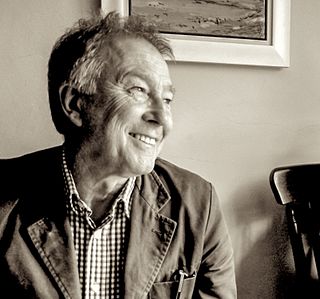
An image is a visual representation. An image can be two-dimensional, such as a drawing, painting, or photograph, or three-dimensional, such as a carving or sculpture. Images may be displayed through other media, including projection on a surface, activation of electronic signals, or digital displays; they can also be reproduced through mechanical means, such as photography, printmaking or photocopying. Images can also be animated through digital or physical processes.

Civilisation—in full, Civilisation: A Personal View by Kenneth Clark—is a 1969 British television documentary series written and presented by the art historian Kenneth Clark.

John Peter Berger was an English art critic, novelist, painter and poet. His novel G. won the 1972 Booker Prize, and his essay on art criticism Ways of Seeing, written as an accompaniment to the BBC series of the same name, was influential. He lived in France for over fifty years.
Visual culture is the aspect of culture expressed in visual images. Many academic fields study this subject, including cultural studies, art history, critical theory, philosophy, media studies, Deaf Studies, and anthropology.
Events from the year 1972 in art.

Graciela Iturbide is a Mexican photographer. Her work has been exhibited internationally, and is included in many major museum collections such as the San Francisco Museum of Modern Art and The J. Paul Getty Museum.

Maurice Berger was an American cultural historian, curator, and art critic, who served as a Research Professor and Chief Curator at the Center for Art, Design and Visual Culture, University of Maryland, Baltimore County. Berger was recognized for his interdisciplinary scholarship on race and visual culture in the United States.
Peter Michael Fuller was a British art critic and magazine editor.

Art history is the study of aesthetic objects and visual expression in historical and stylistic context. Traditionally, the discipline of art history emphasized painting, drawing, sculpture, architecture, ceramics and decorative arts; yet today, art history examines broader aspects of visual culture, including the various visual and conceptual outcomes related to an ever-evolving definition of art. Art history encompasses the study of objects created by different cultures around the world and throughout history that convey meaning, importance or serve usefulness primarily through visual representations.
Richard Hollis Hon. FRSL is a British graphic designer. He has taught at various art schools, written books, and worked as a printer, as a magazine editor and as a print-production manager. Hollis was elected as an Honorary Fellow of the Royal Society of Literature in 2019.
Mike Dibb is an English documentary filmmaker. In almost half a century of making films mainly for television – on subjects including cinema, literature, art, jazz, sport and popular culture – "he has defined and re-defined not only the televisual art documentary genre but has been able to make moving image pieces as a form of self portraiture". Dibb has made many acclaimed films, including on Federico García Lorca, C. L. R. James, Astor Piazzolla, Miles Davis, Keith Jarrett, Barbara Thompson and other notable subjects. In the words of Sukhdev Sandhu in The Guardian: "In a career spanning almost five decades, it's possible Dibb has shaped more ideas and offered more ways of seeing than any other TV documentarian of his generation." Mike Dibb is the father of film director Saul Dibb.
Feminist art criticism emerged in the 1970s from the wider feminist movement as the critical examination of both visual representations of women in art and art produced by women. It continues to be a major field of art criticism.

Victoria Law, familiarly known as Vikki Law, is an American anarchist activist, prison abolitionist, writer, freelance editor, and photographer. Her books are Resistance Behind Bars: The Struggles of Incarcerated Women, Don't Leave Your Friends Behind: Concrete Ways to Support Families in Social Justice Movements and Communities, Prison by Any Other Name: The Harmful Consequences of Popular Reforms, and Prisons Make Us Safer: And 20 Other Myths about Mass Incarceration (2021).
Lorna Mills is a Canadian net.art and new media artist who is known for her digital animations, videos, and GIFs. Mills has done work in other mediums such as installations. Her work explores how "the notion of public decency is anachronistic" Her use of GIFs are gathered through the dark net which includes 4chan, pornfails, and Russian domains. She currently lives and works in Toronto, Canada.

In feminist theory, the male gaze is the act of depicting women and the world in the visual arts and in literature from a masculine, heterosexual perspective that presents and represents women as sexual objects for the pleasure of the heterosexual male viewer. In the visual and aesthetic presentations of narrative cinema, the male gaze has three perspectives: that of the man behind the camera, that of the male characters within the film's cinematic representations; and that of the spectator gazing at the image.

James Bridle is an artist, writer and publisher based in London. Bridle coined the New Aesthetic; their work "deals with the ways in which the digital, networked world reaches into the physical, offline one." Their work has explored aspects of the western security apparatus including drones and asylum seeker deportation. Bridle has written for WIRED, Icon, Domus, Cabinet Magazine, The Atlantic and many other publications, and writes a regular column for The Guardian on publishing and technology.

John Christie is a visual artist and broadcast film-maker. As a maker of artists’ books since 1975, he has produced more than 20 limited editions for both the renowned Circle Press and his own imprint Objectif. Alongside John Berger, he co-authored the award-winning book I Send You This Cadmium Red. His prints, drawings and artists’ books are in many collections worldwide including the Tate Gallery, the V&A, the Yale Center for British Art, New Haven, New York Public Library and the National Library of Australia.
Vikki Tobak is a culture journalist, author, independent curator, and producer born in Soviet-era Kazakhstan who was raised in the United States. She reports about and creates content regarding politics, arts, social justice and music photography.

Contact High: A Visual History of Hip-Hop is a 2018 photography book created and written by Vikki Tobak and ongoing exhibition series. The volume features contact prints from analog photography sessions of hip hop artists during roughly forty-years, from the beginnings of the genre in the late 1970s until the late 2000s.

Susanna and the Elders is an Old Testament story of a woman falsely accused of adultery after she refuses two men who, after discovering one another in the act of spying on her while she bathes, conspire to blackmail her for sex. Depictions of the story date back to the late 3rd/early 4th centuries and are still being created.












